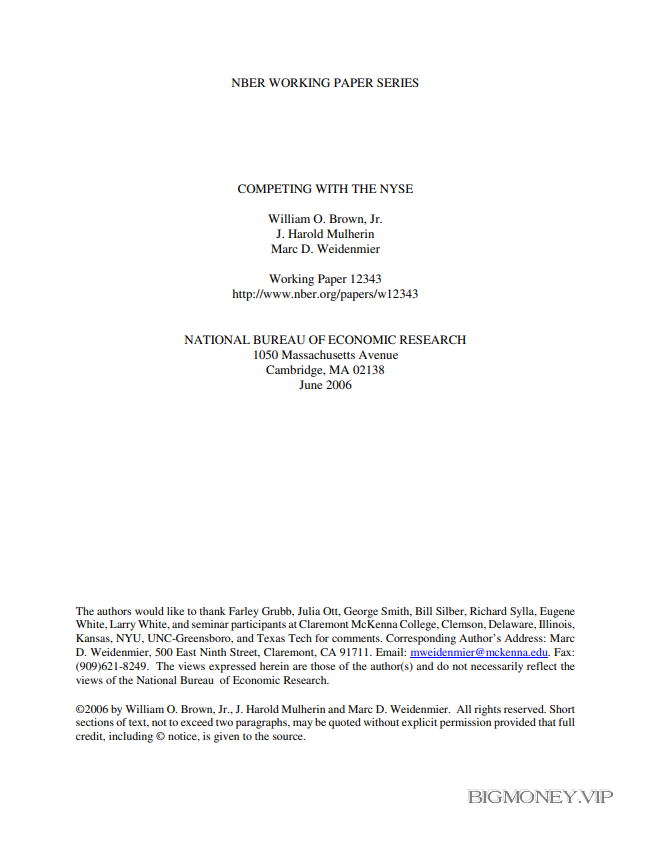COMPETING WITH THE NYSE by William O. Brown, Jr., J. Harold Mulherin and Marc D. Weidenmier

Competing with the NYSE
For a significant part of its 213-year history, the New York Stock Exchange (NYSE) has
reigned as the leading stock exchange both within the United States and across the world.
Recently, ongoing changes in technology and the globalization of stock trading have given rise to
a number of competitors that threaten the NYSE’s position as the preeminent stock exchange.
Technological change has played an important role in fostering the development of alternative
trading systems (Macey and O’Hara, 1999). The globalization of trading may have large and
significant effects on financial markets (Ramos, 2003). Indeed, in the July 21, 2005, S-4 filing
related to its proposed merger with Archipelago, a rival exchange, the NYSE identifies the
growth of global capital markets and the emergence of electronic communications networks as a
significant threat to its dominant market share (p. 141).
The recently completed merger between the two exchanges raises many questions about
the effects of head-to-head stock market competition with the NYSE. Unfortunately, prior
empirical evidence offers little insight into this important public policy question. Research
focusing on past (e.g., Branch and Freed (1977), Hamilton (1976, 1979, 1987), Tinic (1972)) and
more recent episodes (e.g., Battalio (1997), Battalio, Greene and Jennings (1997)) of direct
trading competition with the NYSE has studied relatively minor magnitudes of off-exchange
trading by regional exchanges and/or the third market. Much of this minimal competition was
often related to regulatory mandates by the Securities and Exchange Commission. (See Jarrell
(1984) and Arnold, Hersch, Mulherin and Netter (1999).)
The lack of evidence on established NYSE competitors raises an even more fundamental
question: Is the NYSE susceptible to significant competition? Previous work by Stigler (1961,
1964) suggests that the NYSE has natural monopoly characteristics and Chowdry and Nanda
(1991) model the “winner takes most” feature of securities market trading concentration. The
empirical evidence of Demsetz (1968) and Doede (1967) finds that the NYSE has economies of
scale and scope in securities trading and Hasan and Malkamaki (2001) report related findings for
securities markets in the 1990s. Moreover, recent work by Barclay, Hendershott and McCormick
(2003) reports that although electronic communication networks (ECNs) have made significant
inroads against NASDAQ, the ECNs have made a much smaller dent in the trading of NYSE
listings.
In this paper, we provide new evidence on both the viability and the nature of direct
trading competition with the NYSE. We study the Consolidated Stock Exchange, a rival stock
exchange that competed directly with the “Big Board” from 1885 to 1926. For almost 42 years,
the Consolidated was an important competitor and garnered an average annual market share
reaching as high as 60 percent of NYSE trading volume. This sustained incidence of competition
with the NYSE came at a time of significant technological change in securities trading and
thereby has direct relevance to the current competitive forces confronting the NYSE today.
Although the Consolidated has been noted in historical research by Nelson (1907), Garvy
(1944), and Sobel (1972) and in more recent analysis of the property rights to price quotations by
Mulherin, Netter and Overdahl (1991), there is little or no systematic analysis of this exchange’s
impact on the NYSE. Indeed, in an otherwise insightful and comprehensive analysis, Doede
(1967) discounts the importance of the rival exchange due to the absence of reported data on
Consolidated trading volume (p. 27). We fill the historical and empirical void of this important
episode of stock exchange competition with newly collected data from The New York Times and
other sources.
Our analysis focuses on the effects of competition on the bid-ask spreads for NYSE
stocks. We employ a series of complementary tests to identify the effects of stock market
competition. We first study the impact of competition on bid-ask spreads when the Consolidated
began to trade NYSE stocks in 1885. Then we analyze the effects of competition on bid-ask
spreads for approximately 40 years of the stock exchange rivalry. Our results suggest that NYSE
bid-ask spreads fell by more than 10 percent when the Consolidated began to trade NYSE stocks
COMPETING WITH THE NYSE by William O. Brown, Jr., J. Harold Mulherin and Marc D. Weidenmier




